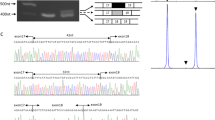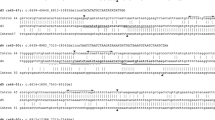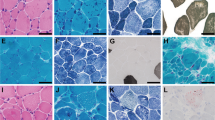Abstract
We report the mapping of a second myotonic dystrophy locus, myotonic dystrophy type 2 (DM2). Myotonic dystrophy (DM) is a multi-system disease and the most common form of muscular dystrophy in adults1. In 1992, DM was shown to be caused by an expanded CTG repeat in the 3´ untranslated region of the dystrophia myotonica-protein kinase gene (DMPK) on chromosome 19 (refs 2, 3, 4, 5, 6). Although several theories have been put forth to explain how the CTG expansion causes the broad spectrum of clinical features associated with DM, it is not understood how this mutation, which does not alter the protein-coding region of a gene, causes an affect at the cellular level7,8. We have identified a five-generation family (MN1) with a genetically distinct form of myotonic dystrophy. Affected members exhibit remarkable clinical similarity to DM (myotonia, proximal and distal limb weakness, frontal balding, cataracts and cardiac arrhythmias) but do not have the chromosome-19 CTG expansion. We have mapped the disease locus (DM2) of the MN1 family to a 10-cM region of chromosome 3q. Understanding the common molecular features of two different forms of the disease should shed light on the mechanisms responsible for the broad constellation of seemingly unrelated clinical features present in both diseases.
This is a preview of subscription content, access via your institution
Access options
Subscribe to this journal
Receive 12 print issues and online access
$209.00 per year
only $17.42 per issue
Buy this article
- Purchase on Springer Link
- Instant access to full article PDF
Prices may be subject to local taxes which are calculated during checkout


Similar content being viewed by others
References
Harper, P.S. Myotonic Dystrophy (W.B. Saunders, London, 1989)
Fu, Y.-H. et al. Variation of the CGG repeat at the fragile X site results in genetic instability: Resolution of the Sherman paradox. Cell 67, 1047–1058 (1991)
Buxton, J. et al. Detection of an unstable fragment of DNA specific to individuals with myotonic dystrophy. Nature 355, 547–548 (1992)
Harley, H.G. et al. Expansion of an unstable DNA region and phenotypic variation in myotonic dystrophy . Nature 355, 545–546 (1992)
Brook, J.D. et al. Molecular basis of myotonic dystrophy: Expansion of a trinucleotide (CTG) repeat at the 3' end of a transcript encoding a protein kinase family member . Cell 68, 799–808 (1992)
Mahadevan, M. et al. Myotonic Dystrophy mutation: an unstable CTG repeat in the 3' untranslated region of the gene. Science 255, 1253–1255 (1992)
Wieringa, B. Myotonic dystrophy reviewed: back to the future? Hum. Mol. Genet. 3, 1–7 (1994)
Hamshere, M. & Brook, J.D. Myotonic dystrophy, knockouts, warts and all. Trends Genet. 12, 332–334 (1996)
Koob, M. et al. Rapid cloning of expanded trinucleotide repeat sequences from genomic DNA . Nature Genet. 18, 72–75 (1998)
Thornton, C.A., Griggs, R.C. & Moxley, R.T. Myotonic dystrophy with no trinucleotide repeat expansion . Ann. Neurol. 35, 269–272 (1994)
Rowland, L.P. Thornton-Griggs-Moxley disease: myotonic dystrophy type 2. Ann. Neurol. 36 , 803–804 (1994)
Ricker, K. et al. Proximal myotonic myopathy: a new dominant disorder with myotonia, muscle weakness, and cataracts. Neurology 44, 1448 –1452 (1994)
Abbruzzese, C. et al. Myotonic dystrophy phenotype without expansion of (CTG)n repeat: an entity distinct from proximal myotonic myopathy (PROMM)? J. Neurol. 243, 715–721 (1996)
Weber, J.L. & Wong, C. Mutation of human short tandem repeats . Hum. Mol. Genet. 2, 1123–1128 (1993)
Lathrop, G.M., Lalouel, J.M., Julier, C. Ott, J. Strategies for multilocus linkage analysis in humans. Proc. Natl. Acad. Sci. USA 81, 3443–3446 (1984)
Weeks, D.E., Sobel, E., O'Connell, J.R. Lange, K. Computer programs for multilocus haplotyping of general pedigrees. Am. J. Hum. Genet. 56, 1506–1507 (1996)
Sobel, E. Lange, K. Descent graphs in pedigree analysis: applications to haplotyping, location scores, and marker-sharing statistics. Am. J. Hum. Genet. 58, 1323–1337 (1996)
Acknowledgements
We thank family members for their participation, J. Lundgren for technical assistance and C. Peterson, C. Hauser and B. LeRoy for help with family history information and clinical visits. We are grateful to D. Weeks for his assistance with the SIMWALK2 program. This work was supported by the Graduate School of the University of Minnesota and by The National Institutes of Health (R01 NS35870).
Author information
Authors and Affiliations
Corresponding author
Rights and permissions
About this article
Cite this article
Ranum, L., Rasmussen, P., Benzow, K. et al. Genetic mapping of a second myotonic dystrophy locus. Nat Genet 19, 196–198 (1998). https://doi.org/10.1038/570
Received:
Accepted:
Issue Date:
DOI: https://doi.org/10.1038/570
This article is cited by
-
The DM-scope registry: a rare disease innovative framework bridging the gap between research and medical care
Orphanet Journal of Rare Diseases (2019)
-
SCN4A as modifier gene in patients with myotonic dystrophy type 2
Scientific Reports (2018)
-
Comparative Sleep Disturbances in Myotonic Dystrophy Types 1 and 2
Current Neurology and Neuroscience Reports (2018)
-
Myotonic dystrophy type 2 and modifier genes: an update on clinical and pathomolecular aspects
Neurological Sciences (2017)
-
Biomolecular diagnosis of myotonic dystrophy type 2: a challenging approach
Journal of Neurology (2017)



